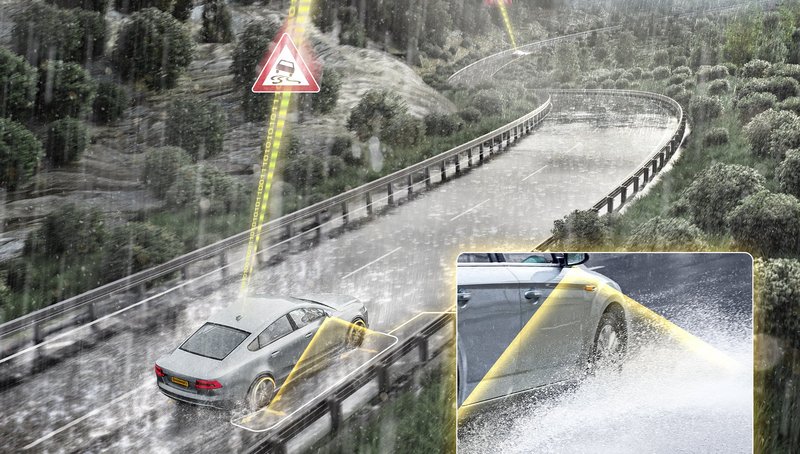Continental Unveils New Assistance Concepts for Early Risk Detection of Aquaplaning Situations
- Continental is developing new concepts designed to warn drivers about an imminent risk of aquaplaning
- Aquaplaning assistance concepts utilize surround view camera images and signals from tire-mounted sensors (eTIS) for advanced tire information
- The holistic concept can give the driver time to prevent the front wheels of the vehicle from floating, while warning other vehicles to be prepared for a critical situation
Frankfurt am Main, Germany, April 12, 2018. Dry, icy, snowy, or wet: awareness of road conditions is a crucial safety factor as accidents in severe weather arise mainly due to significant loss of friction between tires and the surface of the road. With its Road Condition Observer, Continental has introduced a solution that allows road conditions to be classified with regard to tire/road friction. A specific situation called aquaplaning is extremely dangerous for manually driven vehicles as well as automated ones. Technology company Continental has now begun to develop new sensor-based concepts to warn the driver in the event of imminent loss of friction. When there is a thick layer of water on the road, the water pressure between the tire footprint and the road surface can make the front wheels float. Braking and steering are no longer possible, and the driver loses control of the vehicle.
“Wet road conditions are difficult for a car driver to evaluate,” said Bernd Hartmann, head of Enhanced ADAS (Advanced Driver Assistance Systems) & Tire Interactions within the Advanced Technology department of Continental’s Chassis & Safety division. “Once you feel your vehicle floating, it is too late. Our aquaplaning assistance concepts detect the early aquaplaning phase to make the driver aware of what is going on under the tires. This can help drivers or automated vehicles to adapt their speed appropriately to wet road conditions.”
The system under development is all encompassing – tires, tire-sensors, cameras, algorithms, brake actuation, and the human-machine interface.
Predictive Aquaplaning Risk Recognition
Continental’s developers are focused on predicting and managing the risk of aquaplaning. The objective is to detect a possible front-wheels floating situation as early as possible in order to trigger an early warning to the driver. Utilizing signals from surround view cameras and tire-mounted eTIS (electronic-Tire Information System) sensors, an early warning concerning the approaching aquaplaning situation is provided to the driver. Continental is also working on the control and stabilization of vehicles in aquaplaning situations, such as torque vectoring by individual wheel braking.
Aquaplaning conditions can also occur unexpectedly with no opportunity for advance warning. In such cases, the potential risk to other vehicles on the road can be mitigated by early communication via V2X technology and eHorizon, facilitating a network of solidarity where one vehicle acts as a safety sensor for all other vehicles and not just those in its direct vicinity. eHorizon can provide this information to vehicles that could potentially be affected, so they are able to adjust their driving functions to the aquaplaning conditions.
Detecting an imminent loss of control through sensor re-use
To detect aquaplaning situations, video images from surround view cameras mounted in the side mirrors, the grill, and rear are analyzed. “When there is a lot of water on the road, the camera images show a specific splash and spray pattern from the tires that can be detected as aquaplaning in its early phase”, explained Hartmann. For example, excessive water displacement in all directions underneath the tire is a characteristic attribute. During the first testing phase of the new solution, the wetness recognition algorithms delivered a very high hit ratio in predicting potential aquaplaning conditions.
In addition to image information, Continental uses information from tires to detect the risk of aquaplaning. In this concept, signals from Continental’s eTIS sensors, mounted on the tire’s inner liner, are computed. “We use the accelerometer signal from the electronic-Tire Information System to look for a specific signal pattern”, said Andreas Wolf, head of Continental's Body & Security business unit. A tire model processes the incoming radial acceleration of the part of the tire that is in contact with the road. For wet roads – when enough water is transported out of the tire tread to ensure an appropriate grip – the signal shows a distinct pattern. As soon as a wedge of water begins to form in front of the tire footprint region and there is excessive water on the road, the acceleration signal begins to oscillate in a characteristic way, indicating an early risk of aquaplaning. Since the eTIS sensors can also detect the remaining tire tread depth, a safe speed for a given wet road condition can be calculated and communicated to the driver.
Testing has shown that future aquaplaning assistance will also have the potential to intervene in an actual aquaplaning situation by applying the rear brakes in a controlled way to establish a degree of “torque vectoring” in order to maintain vehicle maneuverability within physical limits.
Contribution to Vision Zero
Not only is aquaplaning a challenge to the driver, but it is also difficult to pin down how many country road and highway accidents in wet road conditions are caused by floating front wheels. “This is one of the last white spots on the strategic map towards greater road safety”, said Bernd Hartmann. But drivers must continue to consider a general rule: adjusting their speed to wet roads and keeping an eye on the tire’s tread depth. Since aquaplaning depends on tread depth, the height of the water on the road and speed, Continental recommends renewing summer tires with three millimeters of residual tread depth. Below this limit, the risk of aquaplaning increases significantly. The experts advise drivers in principle to reduce their speed on wet roads or in the rain.

Sören Pinkow
Media Spokesperson Autonomous Mobility and Commercial Vehicles
Continental Automotive

Sebastian Fillenberg
Head of External Communications
Continental Automotive


